Design and Optimization of γ-Shaped Settlement Training Wall Based on Numerical Simulation and CCD-Response Surface Method
Abstract
:1. Introduction
2. Research Area and Object
3. Study Method
3.1. Numerical Simulation
3.2. Response Surface Method
3.3. Notability Analysis
4. Scheme Design and Result Analysis
4.1. Selection of Research Indicators
4.2. Scheme Design and Result Calculation
4.3. Model Fitting and Notability Analysis
4.4. Parameter Optimization
5. Numerical Simulation and Scheme Verification
5.1. Feature Section Selection
5.2. Analysis of Numerical Simulation Results
5.2.1. Operational State of Pumping
5.2.2. Operational State of Free-Draining
6. Discussion
7. Conclusions
- (1)
- For the joint hub of pump station and sluice, there was a large area of oblique flow often arising near the junction of the sluice and pumping station under any single operating condition, in which case setting the γ-shaped settlement training wall could effectually ameliorate the inflow state.
- (2)
- The variation of the size parameters of γ-shaped settlement training wall can greatly affect its rectification effect. To be specific, in the operational state of pumping, the arc radius of curved part I and the center angle of curved part II were the key factors affecting the variation of flow state while the center angle of curved part I and the radius of curved part II were the secondary factors. In the operational state of free-draining, only the arc radius of curved part III had a prominent impact on the flow state and the other factors such as the arc radius of curved part III, the center angle of curved part IV, and the arc radius of curved part IV were the secondary factors affecting the flow state in front of the sluice.
- (3)
- For the joint hub of the pump station and sluice, the optimal size combination scheme of the γ-shaped settlement training wall was: center angle of curved part I: 43.5°, arc radius of curved part I: 5.36t, center angle of curved part II: 46.2°, arc radius of curved part II: 2.62b, center angle of curved part III: 43.0°, arc radius of curved part III: 6.43b, center angle of curved part IV: 40.6°, and arc radius of curved part IV: 1.37t where b represents the net width of the 7# sluice and t represents the net width of the 6# inlet channel.
- (4)
- This paper designed and optimized a γ-shaped settlement training wall which could ameliorate the inlet conditions of the side wall of the training wall by completely cutting off the interference of lateral reflux, greatly ameliorating the inlet flow state of the joint hub of pump station and sluice under the conditions of pumping and free-draining. Compared with the previous studies, the γ-shaped settlement training wall designed in this study is more applicable and has a rectification effect. Additionally, the CCD-Response surface method was adopted in the case of fluid machinery research. The structural form and the optimization method of the γ-shaped settlement training wall designed in this study can provide technical support for the design of asymmetric joint hub of sluices and pump stations with engineering training walls. In the future, some consideration will be given to the design of γ-shaped settlement training walls with open-cell and the relevant physical model tests will be launched to further verify the rationality of the results of numerical simulation.
Author Contributions
Funding
Institutional Review Board Statement
Informed Consent Statement
Data Availability Statement
Conflicts of Interest
References
- Cao, Q.; Meng, Y.; Chen, L. Nonlinear Finite Elements Analysis on Structure of Pumping Station in the Joint Hub of Sluice and Pumping Station. Appl. Mech. Mater. 2011, 90, 2546–2552. [Google Scholar] [CrossRef]
- Yan, P.; Zhang, Z.; Lei, X. A Simple Method for the Control Time of a Pumping Station to Ensure a Stable Water Level Immediately Upstream of the Pumping Station under a Change of the Discharge in an Open Channel. Water 2021, 13, 355. [Google Scholar] [CrossRef]
- Cao, Q.; Ma, Y. Analysis on the causes of cracks on the Concrete Structure of Large and Medium-sized Pumping Station. Adv. Mater. Res. 2012, 486, 484–491. [Google Scholar] [CrossRef]
- Van, K.; Van, R.; Volken Winter, H. Behavioral responses of eel (Anguilla anguilla) approaching a large pumping station with trash rack using an acoustic camera (DIDSON). Fisheries. Manag. Ecol. 2020, 27, 464–471. [Google Scholar]
- Matsui, J.; Sugino, Y.; Kawakita, K. Numerical simulation on flow in pump sump with free surface. In Proceedings of the 6th International Symposium on Fluid Machinery and Fluid Engineering, Wuhan, China, 22–25 October 2014. [Google Scholar]
- Desmukh, T.S.; Gahlot, V.K. Numerical study of flow behavior in a multiple intake pump sump. Int. J. Adv. Eng. Technol. 2011, 2, 118–128. [Google Scholar]
- Valero, D.; Viti, N.; Gualtieri, C. Numerical simulation of hydraulic jumps. Part 1: Experimental data for modelling performance assessment. Water 2018, 11, 36. [Google Scholar] [CrossRef] [Green Version]
- Al-Mansori, N.J.H.; Laith, S.A.A.; Al-Zubaidi, L.S.A. One-dimensional hydrodynamic modeling of the Euphrates river and prediction of hydraulic parameters. Civ. Eng. J. 2020, 6, 1074–1090. [Google Scholar] [CrossRef]
- Al-Mansori, N.J.H.; Alfatlawi, T.J.M.; Hashim, K.S.; Al-Zubaidi, L.S. The Effects of Different Shaped Baffle Blocks on the Energy Dissipation. Civ. Eng. J. 2020, 6, 961–973. [Google Scholar] [CrossRef]
- Yamini, O.A.; Kavianpour, M.R.; Movahedi, A. Performance of Hydrodynamics Flow on Flip Buckets Spillway for Flood Control in Large Dam Reservoirs. J. Hum. Earth Future 2020, 1, 39–47. [Google Scholar] [CrossRef]
- Yang, F.; Zhang, Y.; Liu, C. Numerical and Experimental Investigations of Flow state and Anti-Vortex Measures of Forebay in a Multi-Unit Pumping Station. Water 2021, 13, 935. [Google Scholar] [CrossRef]
- Fan, J.; Lu, D.; Shi, Z.; Hou, H. Lateral Water Pumping Station Forebay of Jingtai Electric Power Irrigation District Flow State Numerical Simulation and Preventing Silt Research. Int. J. Comput. Eng. 2016, 1, 30–32. [Google Scholar]
- Teaima, I.R.; El-Gamal, T. Improving flow performance of irrigation pump station intake. J. Appl. Water Eng. Res. 2017, 5, 9–21. [Google Scholar] [CrossRef]
- Luo, C.; Qian, J.; Liu, C.; Chen, F.; Xu, J.; Zhou, J. Numerical simulation and test verification on diversion pier rectifying flow in forebay of pumping station for asymmetric combined sluice-pump station project. Trans. Chin. Soc. Agric. Eng. 2015, 31, 100–108. [Google Scholar]
- Su, Y.; Xu, W.; Xu, J.; Li, X. Study on combined rectifier pier to improve water inlet conditions of Weicun hub pump station. People’s Yangtze River 2021, 52, 151–156. (In Chinese) [Google Scholar]
- Xi, B.; Zhen, Y.; Duan, Y.; Yang, X.; Lu, R. Optimization of flow state in forebay of gate station combined pump station. J. Chang. Acad. Sci. 2021, 1, 9–28. (In Chinese) [Google Scholar]
- Xu, B.; Liu, J.; Lu, W. Optimization Design of Y-Shaped Settling Diversion Wall Based on Orthogonal Test. Machines 2022, 10, 91. [Google Scholar] [CrossRef]
- Panapakidis, I.P.; Sarafianos, D.N.; Alexiadis, M.C. Comparative analysis of different grid-independent hybrid power generation systems for a residential load. Renew. Sustain. Energ. Rev. 2012, 16, 551–563. [Google Scholar] [CrossRef]
- Krishan, O.; Suhag, S. Grid-independent PV system hybridization with fuel cell-battery supercapacitor: Optimum sizing and comparative techno-economic analysis. Sustain. Energy Technol. 2020, 37, 100625. [Google Scholar] [CrossRef]
- Chen, X.; Zillé, P.; Shao, L.; Corpetti, T. Optical flow for incompressible turbulence motion estimation. Exp. Fluids 2015, 56, 1–14. [Google Scholar] [CrossRef] [Green Version]
- Axell, L.B.; Liungman, O. A one-equation turbulence model for geophysical applications: Comparison with data and the k–ε model. Environ. Fluid Mech. 2001, 1, 71–106. [Google Scholar] [CrossRef]
- Shaheed, R.; Mohammadian, A.; Kheirkhah, H. A comparison of standard k–ε and realizable k–ε turbulence models in curved and confluent channels. Environ. Fluid. Mech. 2019, 19, 543–568. [Google Scholar] [CrossRef]
- Wang, G.; Zhao, G.; Li, H. Research on optimization design of the heating/cooling channels for rapid heat cycle molding based on response surface method and constrained particle swarm optimization. Expert. Syst. Appl. 2011, 38, 6705–6719. [Google Scholar] [CrossRef]
- Versele, C. A Response Surface Method Approach to Study the Influence of Specifications or Model Parameters on the Multi-objective Optimal Design of Isolated DC–DC Converters. IEEE. Trans. Power Electron. 2012, 27, 3383–3395. [Google Scholar] [CrossRef]
- Sinopoli, L.; Ordonez, M.; Quaicoe, J. Wind turbine rotor modelling using response surface method. Electr. Comput. Eng. 2010, 6, 2–5. [Google Scholar]
- Doebling, S.W.; Hemez, F.M.; Schultze, J.F. A meta-model-based approach to model validation for nonlinear finite element simulations. In Proceedings of the 20th International Modal Analysis Conference (IMAC), Los Angeles, CA, USA, 3 October 2002; pp. 671–678. [Google Scholar]
- Hussain, M.F.; Barton, R.R.; Joshi, S.B. Meta-modeling radial basis functions versus polynomials. Eur. J. Oper. Res. 2002, 138, 142–154. [Google Scholar] [CrossRef]
- Rywinska, A.; Marcinkiewicz, M.; Cibis, E. Optimization of Medium Composition for Erythritol Production from Glycerol by Yarrowia Lipolytica Using Response Surface Method. Prep. Biochem. Biotech. 2015, 45, 515. [Google Scholar] [CrossRef]
- Xue, J. Experimental Study on the Notability of Social Cognitive Components on the Amount of Cognitive Dissonance. Inf. Technol. J. 2013, 12, 5102–5106. [Google Scholar] [CrossRef] [Green Version]
- Xu, B.; Yao, T.; Xia, H.; Gao, C. Experimental study on rectification of perforated diversion pier of Xifeihe sluice station project. J. Water Conserv. Transp. Eng. 2018, 6, 55–61. (In Chinese) [Google Scholar] [CrossRef]
- Ying, Z.; Seberry, J.; Xia, T.; Wysocki, B.J.; Wysocki, T.A. Construction of amicable orthogonal designs of quaternions. Australas. J. Comb. 2009, 44, 19–35. [Google Scholar]
- Xu, B.; Gao, C.; Xia, H.; Lu, W. Influence of geometric parameters of perforated diversion pier on rectification effect of forebay of gate station project. J. Chang. Acad. Sci. 2019, 36, 58–62. (In Chinese) [Google Scholar]
- Xu, B.; Zhang, C.; Li, Z.; Gao, C.; Bi, C. Study on the influence of geometric parameters of diversion pier on navigable flow conditions of gate station joint hub based on CFD. J. Irrig. Drain. 2019, 38, 115–122. (In Chinese) [Google Scholar] [CrossRef]
- China Communications Planning and Design Institute for Water Transportation. Code for Master Design of Shiplocks, 1st ed.; Nanhai Press: Haikou, China, 2002; pp. 305–2001. [Google Scholar]
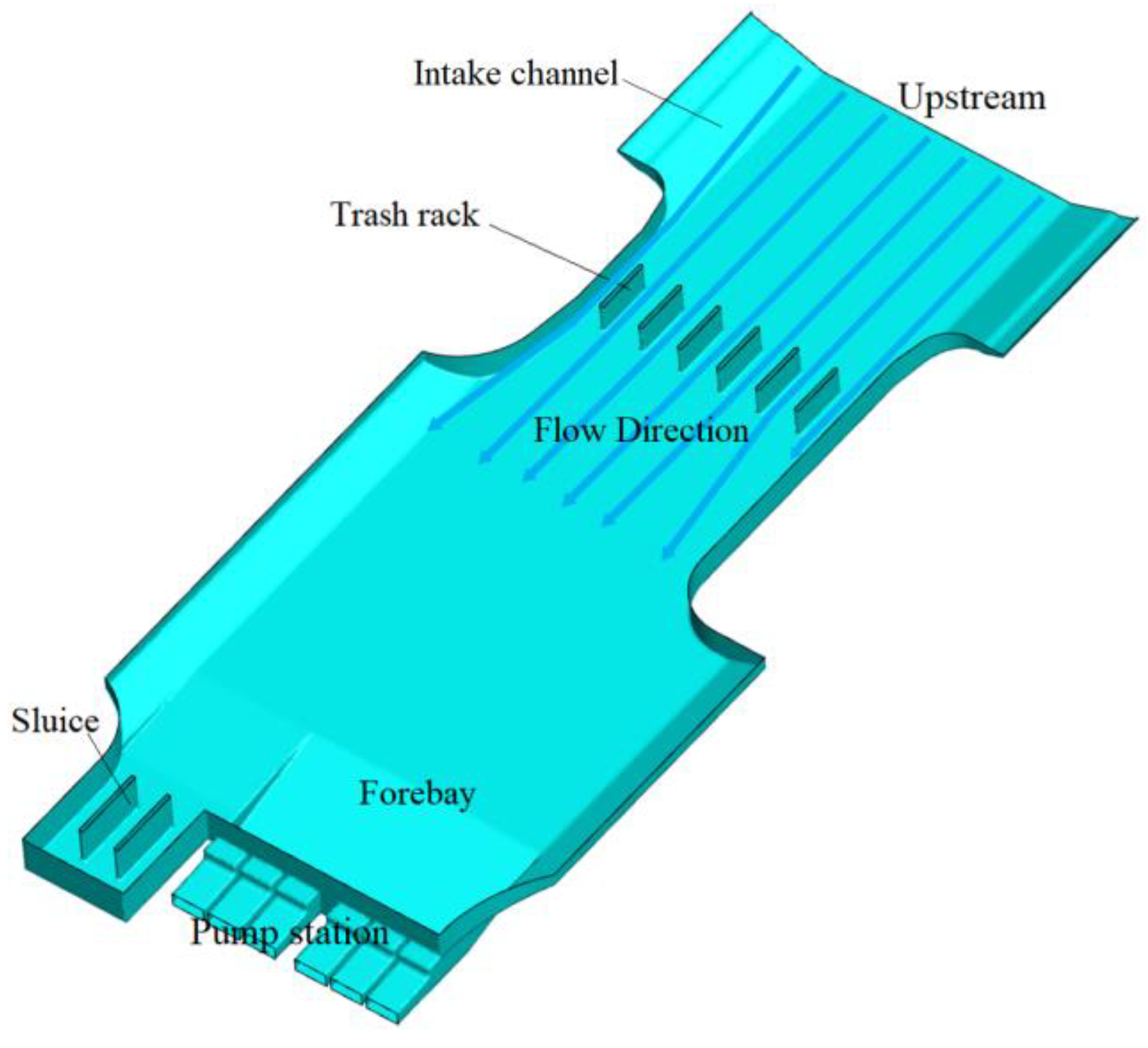
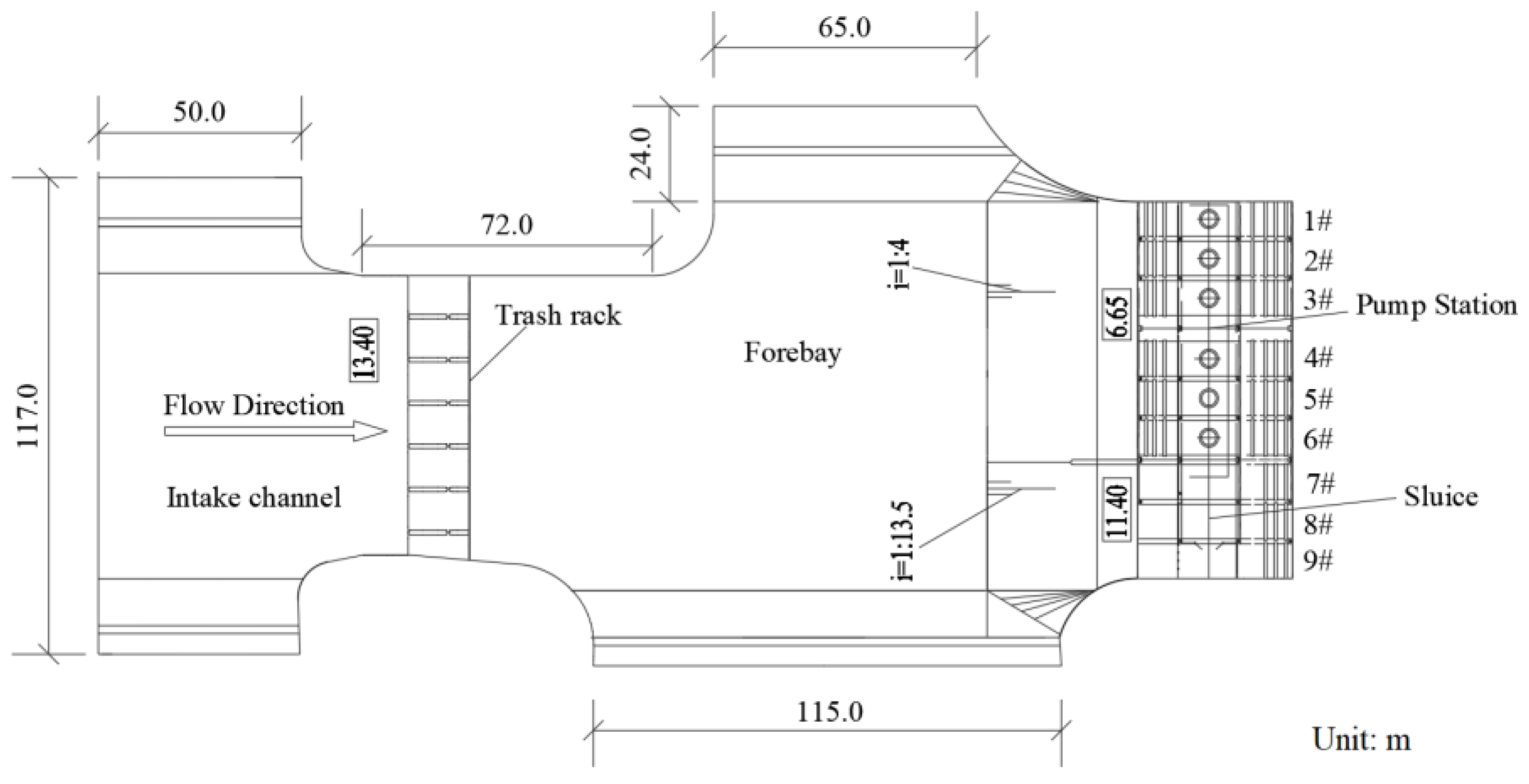

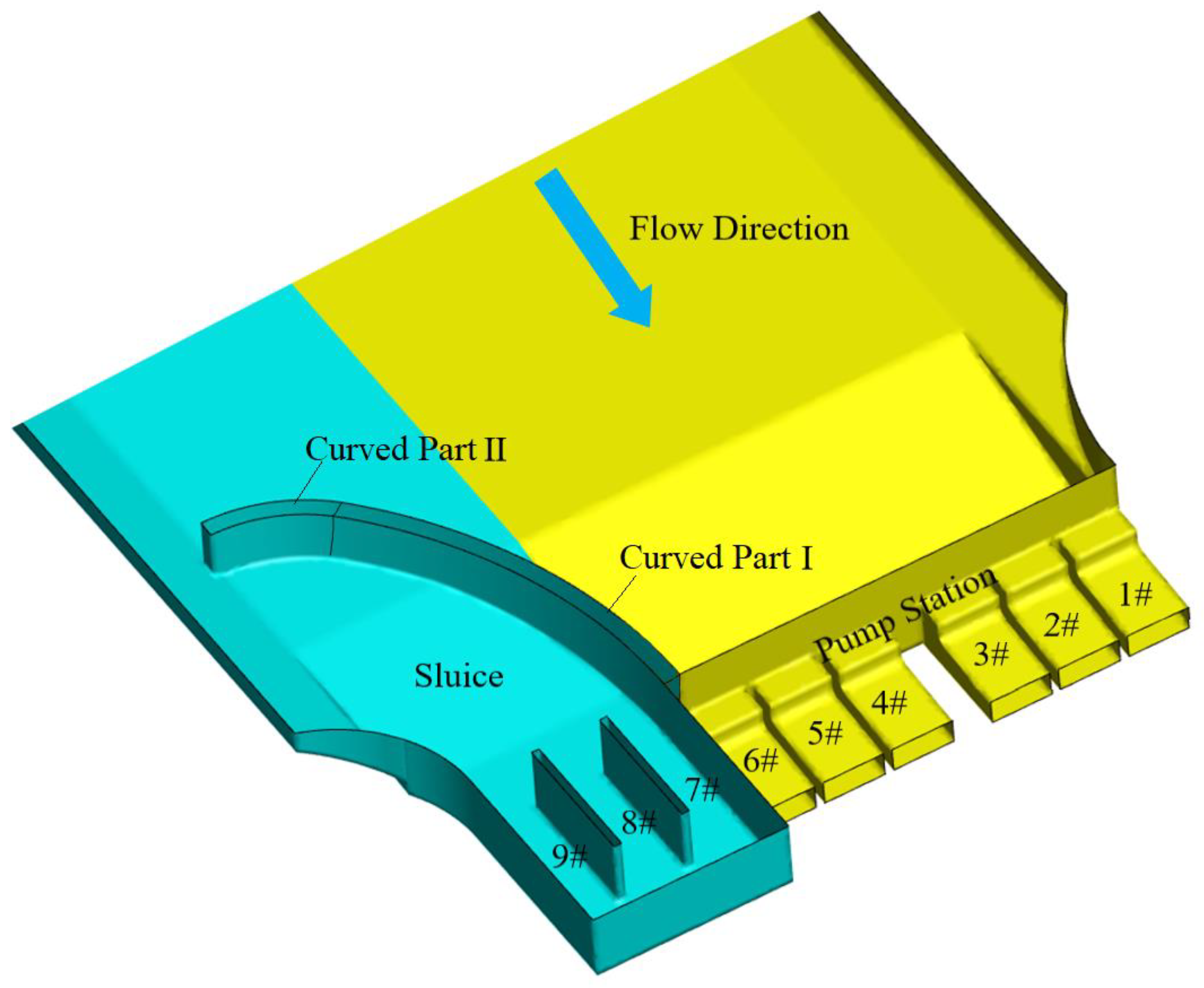


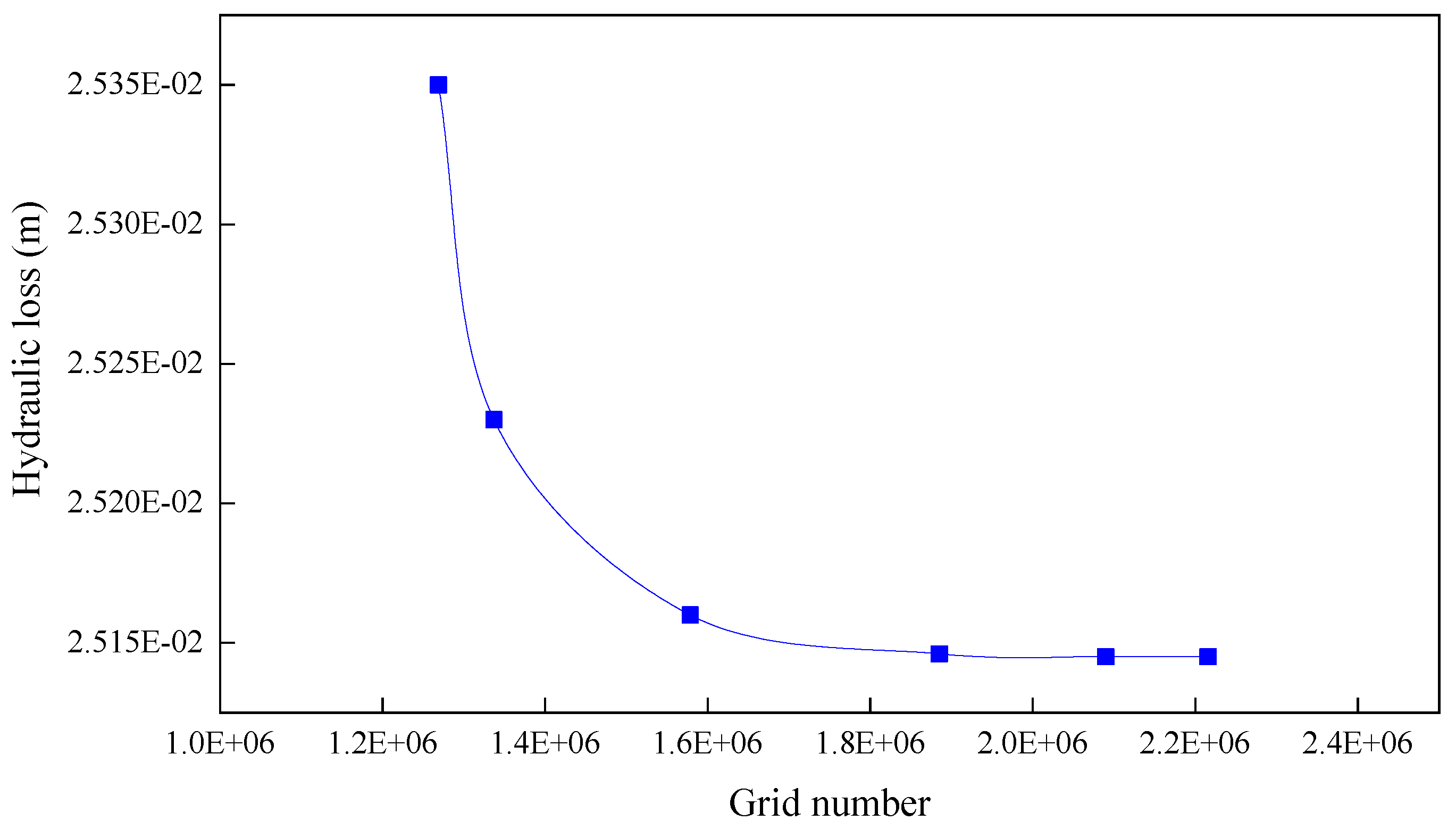
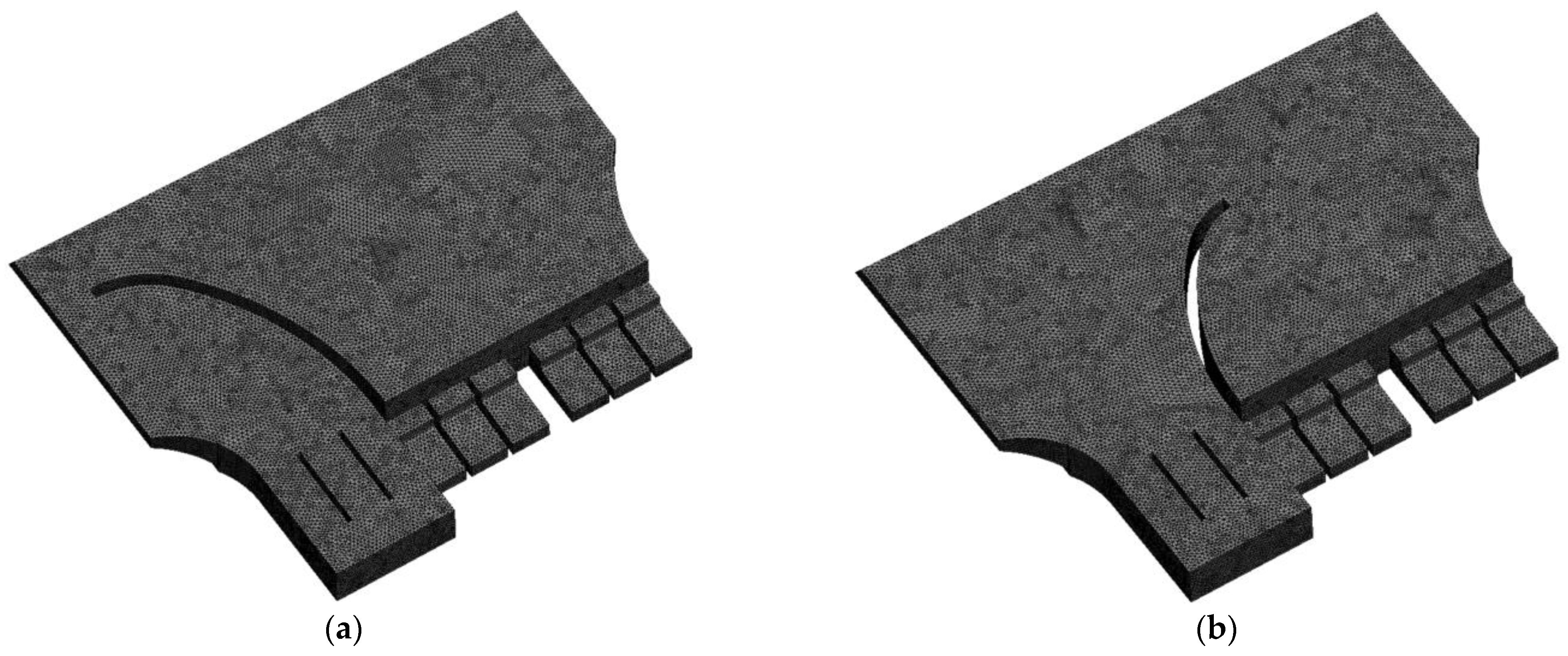

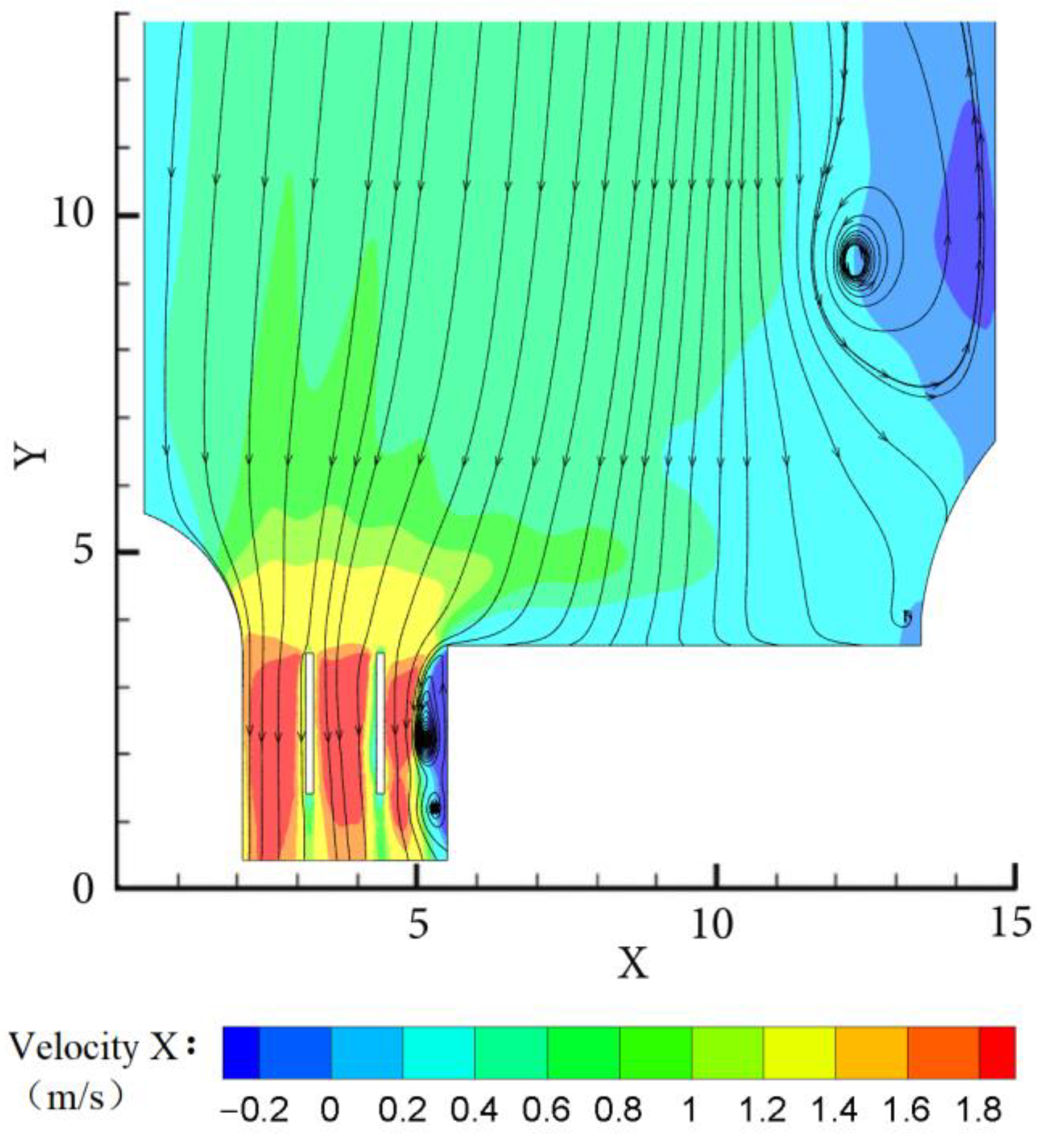


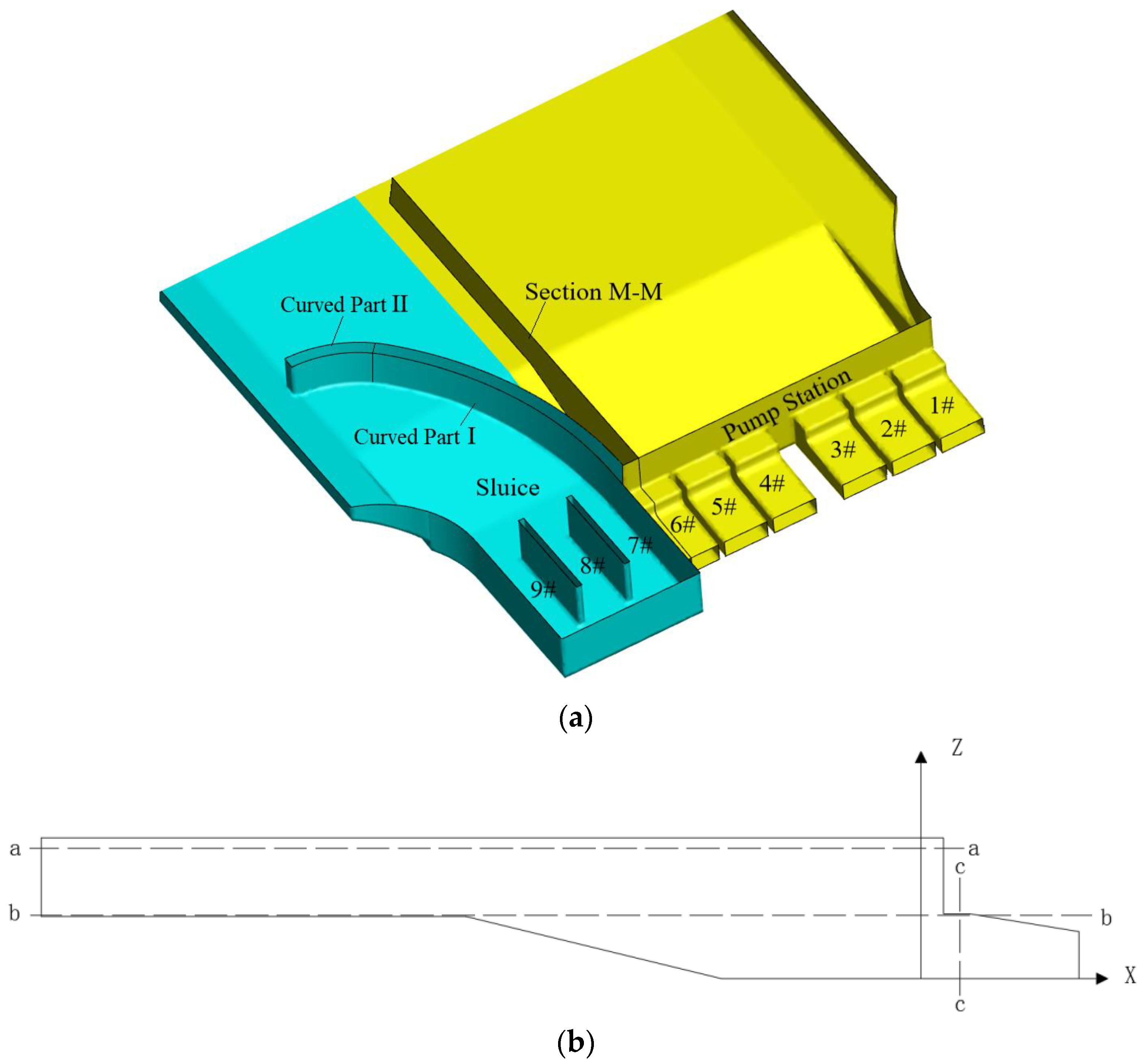
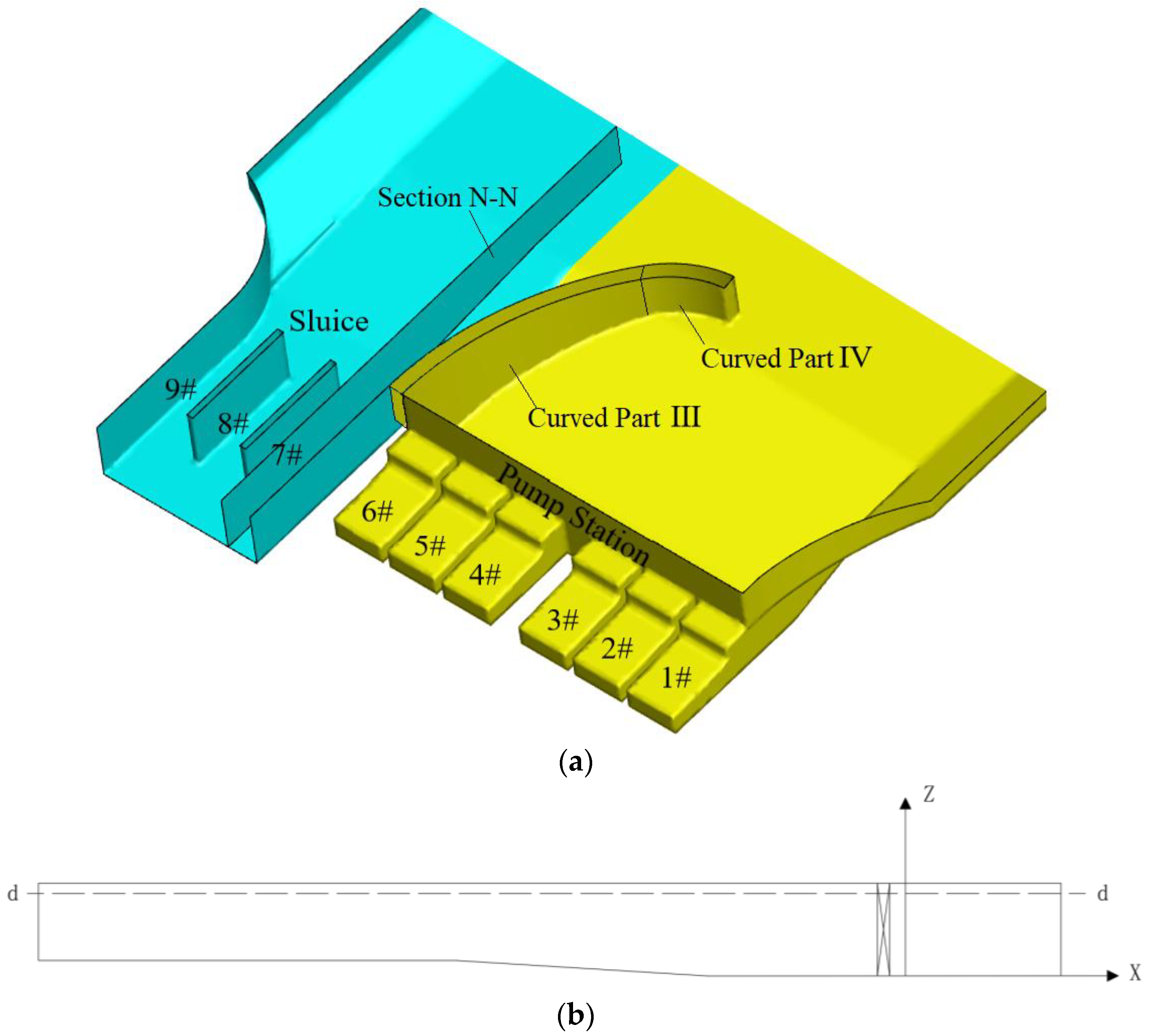

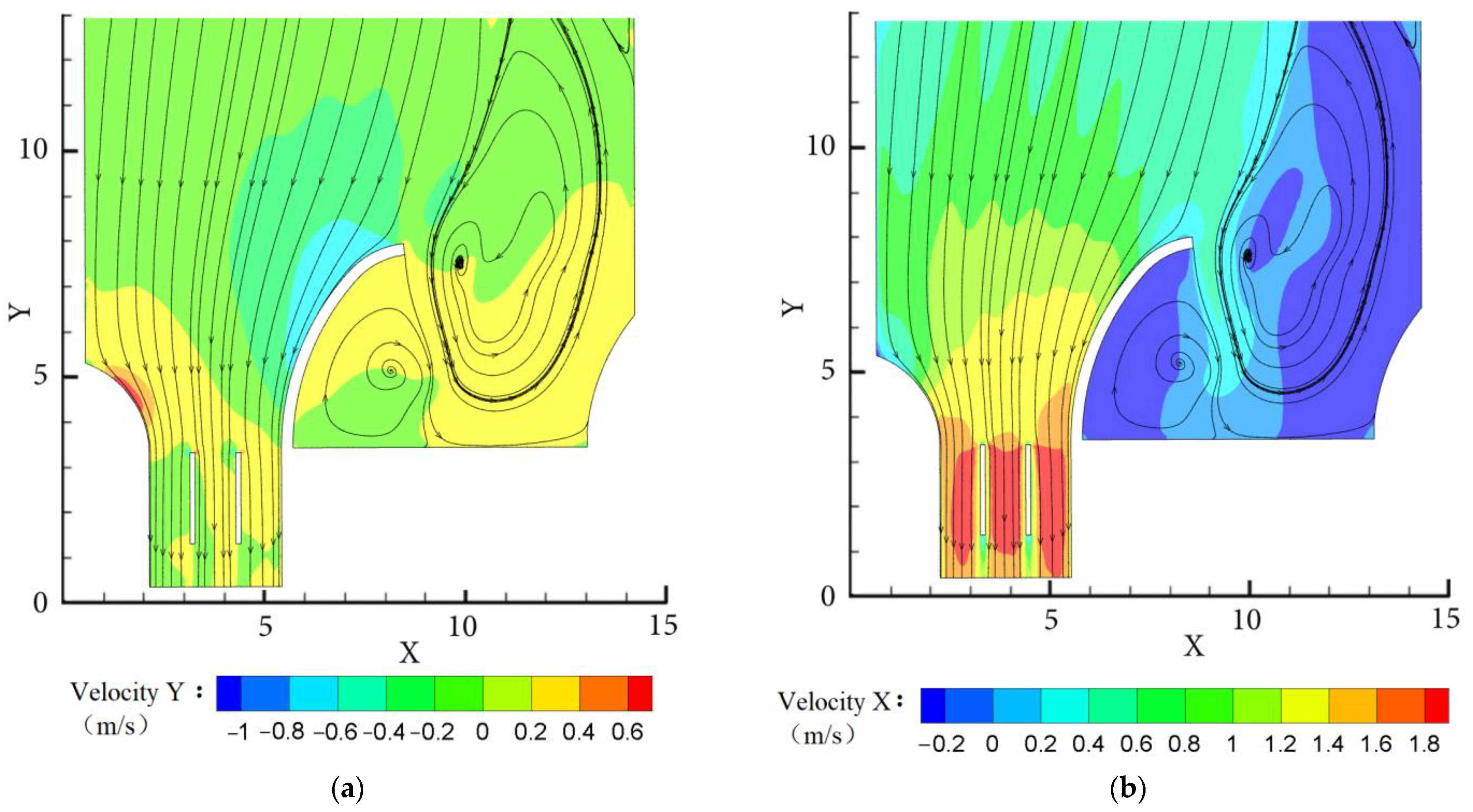
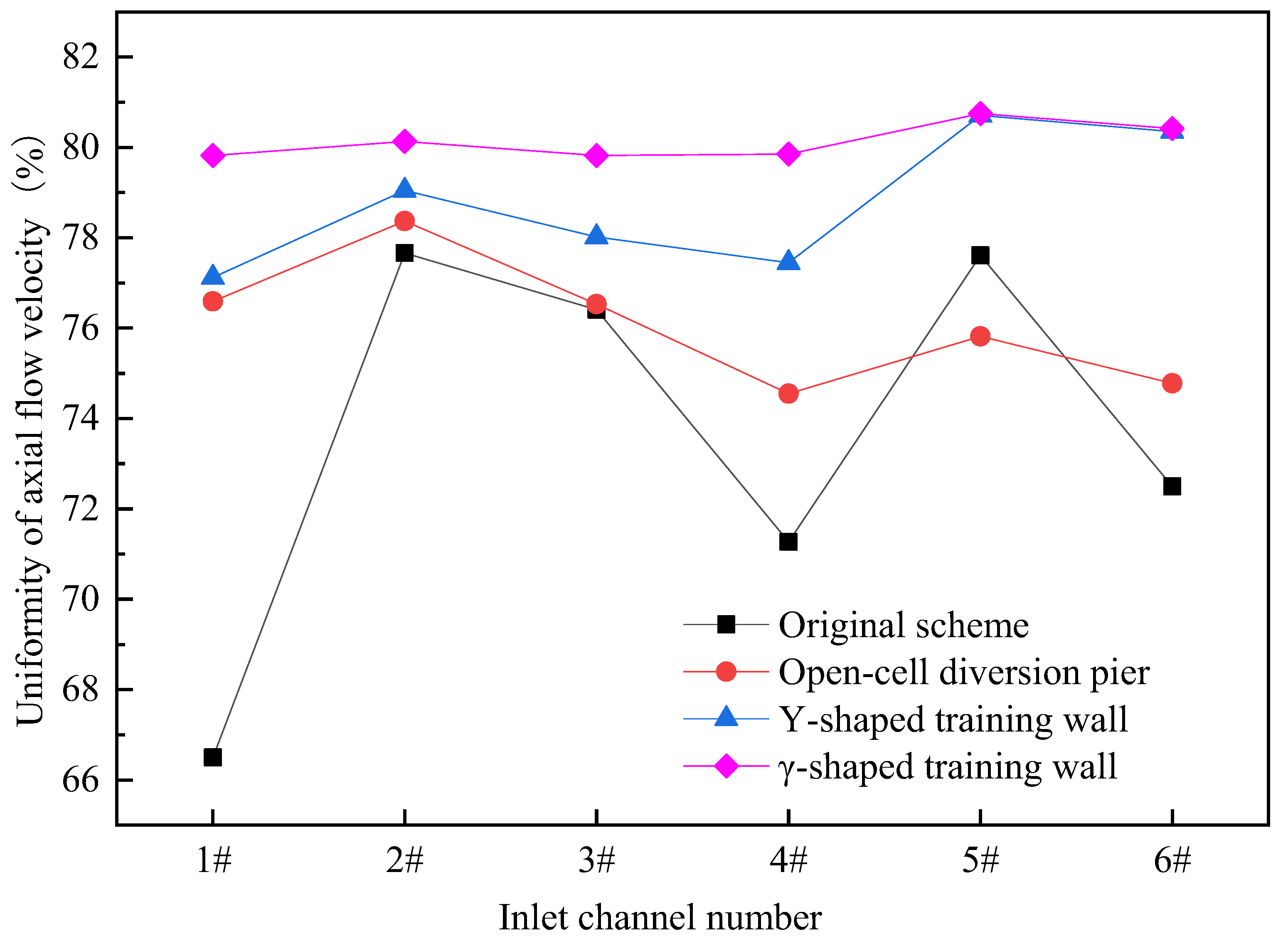

| Level of Code | Factor | |||
|---|---|---|---|---|
| θ1/° | R1 | θ2/° | R2 | |
| −2 | 38 | 4.6t 2 | 44 | 2.2b 1 |
| −1 | 40 | 5.0t 2 | 46 | 2.4b 1 |
| 0 | 42 | 5.4t 2 | 48 | 2.6b 1 |
| 1 | 44 | 5.8t 2 | 50 | 2.8b 1 |
| 2 | 46 | 6.2t 2 | 52 | 3.0b 1 |
| Level of Code | Factor | |||
|---|---|---|---|---|
| θ3/° | R3 | θ4/° | R4 | |
| −2 | 38 | 5.3b 1 | 38 | 1.0t 2 |
| −1 | 40 | 5.9b 1 | 40 | 1.2t 2 |
| 0 | 42 | 6.5b 1 | 42 | 1.4t 2 |
| 1 | 44 | 7.1b 1 | 44 | 1.6t 2 |
| 2 | 46 | 7.7b 1 | 46 | 1.8t 2 |
| Serial Number of Schemes | θ1/° | R1 | θ2/° | R2 | Uniformity of Flow Velocity Distribution (6# inlet Channel)/(%) |
|---|---|---|---|---|---|
| P1 | −2 | 0 | 0 | 0 | 79.95 |
| P2 | 0 | 0 | 0 | 0 | 80.06 |
| P3 | 0 | 0 | 0 | 2 | 77.06 |
| P4 | 1 | −1 | 1 | −1 | 79.23 |
| P5 | 0 | 0 | 0 | 0 | 80.16 |
| P6 | −1 | 1 | 1 | −1 | 77.13 |
| P7 | −1 | 1 | −1 | −1 | 78.54 |
| P8 | 0 | 0 | 0 | −2 | 77.91 |
| P9 | 1 | 1 | 1 | −1 | 78.40 |
| P10 | 1 | −1 | −1 | −1 | 80.12 |
| P11 | 0 | 2 | 0 | 0 | 78.40 |
| P12 | 2 | 0 | 0 | 0 | 79.34 |
| P13 | 1 | 1 | −1 | −1 | 79.82 |
| P14 | 1 | −1 | −1 | 1 | 79.89 |
| P15 | 1 | −1 | 1 | 1 | 78.72 |
| P16 | 1 | 1 | −1 | 1 | 78.46 |
| P17 | 0 | 0 | 0 | 0 | 79.65 |
| P18 | 0 | 0 | 0 | 0 | 78.56 |
| P19 | 1 | 1 | 1 | 1 | 79.15 |
| P20 | −1 | −1 | 1 | 1 | 79.76 |
| P21 | 0 | 0 | 0 | 0 | 79.85 |
| P22 | −1 | −1 | 1 | −1 | 78.66 |
| P23 | 0 | −2 | 0 | 0 | 78.83 |
| P24 | 0 | 0 | 0 | 0 | 79.85 |
| P25 | −1 | 1 | 1 | 1 | 77.69 |
| P26 | −1 | −1 | −1 | 1 | 78.76 |
| P27 | 0 | 0 | −2 | 0 | 79.81 |
| P28 | −1 | 1 | −1 | 1 | 77.92 |
| P29 | 0 | 0 | 2 | 0 | 79.83 |
| P30 | −1 | −1 | −1 | −1 | 78.69 |
| Serial Number of Schemes | θ3/° | R3 | θ4/° | R4 | Uniformity of Flow Velocity Distribution (7# Sluice)/(%) |
|---|---|---|---|---|---|
| S1 | 0 | 0 | 0 | −2 | 81.41 |
| S2 | −1 | 1 | −1 | 1 | 79.92 |
| S3 | 0 | 0 | 0 | 0 | 84.35 |
| S4 | 2 | 0 | 0 | 0 | 82.34 |
| S5 | 1 | 1 | −1 | 1 | 83.46 |
| S6 | 0 | 0 | 0 | 0 | 84.35 |
| S7 | 0 | 0 | 0 | 2 | 80.06 |
| S8 | 0 | 0 | 2 | 0 | 82.83 |
| S9 | 1 | −1 | 1 | −1 | 82.23 |
| S10 | 0 | 0 | 0 | 0 | 84.35 |
| S11 | 1 | 1 | 1 | 1 | 82.15 |
| S12 | 1 | 1 | −1 | −1 | 82.82 |
| S13 | −1 | −1 | 1 | 1 | 81.76 |
| S14 | 0 | 0 | −2 | 0 | 83.31 |
| S15 | −2 | 0 | 0 | 0 | 81.95 |
| S16 | −1 | −1 | 1 | −1 | 80.66 |
| S17 | −1 | −1 | −1 | 1 | 82.76 |
| S18 | 0 | −2 | 0 | 0 | 82.33 |
| S19 | −1 | −1 | −1 | −1 | 80.69 |
| S20 | 1 | −1 | −1 | −1 | 83.12 |
| S21 | 0 | 0 | 0 | 0 | 84.06 |
| S22 | 0 | 2 | 0 | 0 | 81.38 |
| S23 | 1 | −1 | −1 | 1 | 82.89 |
| S24 | 0 | 0 | 0 | 0 | 84.06 |
| S25 | −1 | 1 | 1 | −1 | 79.13 |
| S26 | −1 | 1 | 1 | 1 | 81.19 |
| S27 | 1 | −1 | 1 | 1 | 81.72 |
| S28 | 0 | 0 | 0 | 0 | 84.06 |
| S29 | −1 | 1 | −1 | −1 | 80.54 |
| S30 | 1 | 1 | 1 | −1 | 81.40 |
| Source of Variation | Sum of Deviation | Degree of Freedom | Uniformity of Flow Velocity Distribution of the Admission Section of the 6# Channel | ||
|---|---|---|---|---|---|
| Mean Square Deviation | F | p | |||
| Model | 30.41 | 14 | 2.17 | 4.55 | 0.0031 |
| θ1 | 1.22 | 1 | 1.22 | 2.56 | 0.1304 |
| R1 | 2.39 | 1 | 2.39 | 5.01 | 0.0408 |
| θ2 | 2.29 | 1 | 2.29 | 4.8 | 0.0447 |
| R2 | 0.1768 | 1 | 0.1768 | 0.37 | 0.5521 |
| θ1R1 | 2.61 | 1 | 2.61 | 5.46 | 0.0338 |
| θ1θ2 | 0.2809 | 1 | 0.2809 | 0.5878 | 0.4552 |
| θ1R2 | 0.3782 | 1 | 0.3782 | 0.7914 | 0.3877 |
| R1θ2 | 0.1024 | 1 | 0.1024 | 0.2143 | 0.6501 |
| R1R2 | 0.0756 | 1 | 0.0756 | 0.1582 | 0.6964 |
| θ2R2 | 0.0001 | 1 | 0.0001 | 0.0002 | 0.9886 |
| θ1² | 1.54 | 1 | 1.54 | 3.23 | 0.0926 |
| R1² | 6.71 | 1 | 6.71 | 14.04 | 0.0019 |
| θ2² | 1.03 | 1 | 1.03 | 2.15 | 0.1637 |
| R2² | 16.56 | 1 | 16.56 | 34.66 | <0.0001 |
| Residual | 7.17 | 15 | 0.4779 | ||
| Lack of Fit | 7.04 | 10 | 0.7042 | 27.91 | 0.0009 |
| Pure Error | 0.1261 | 5 | 0.0252 | ||
| Cor Total | 37.58 | 29 | |||
| Source of Variation | Deviation Sum of Squares | Degree of Freedom | Uniformity of Flow Velocity Distribution of the Admission Section in Front of the 7# Sluice | ||
|---|---|---|---|---|---|
| Mean Square Deviation | F | p | |||
| Model | 50.34 | 14 | 3.60 | 5.90 | 0.0008 |
| θ3 | 8.07 | 1 | 8.07 | 13.24 | 0.0024 |
| R3 | 2.09 | 1 | 2.09 | 3.43 | 0.0840 |
| θ4 | 2.00 | 1 | 2.00 | 3.27 | 0.0906 |
| R4 | 0.2731 | 1 | 0.2731 | 0.4478 | 0.5135 |
| θ3R3 | 1.54 | 1 | 1.54 | 2.52 | 0.1332 |
| θ3θ4 | 0.8190 | 1 | 0.8190 | 1.34 | 0.2646 |
| θ3R4 | 0.9801 | 1 | 0.9801 | 1.61 | 0.2242 |
| R3θ4 | 0.0030 | 1 | 0.0030 | 0.0050 | 0.9448 |
| R3R4 | 0.0100 | 1 | 0.0100 | 0.0164 | 0.8998 |
| θ4R4 | 0.1482 | 1 | 0.1482 | 0.2431 | 0.6291 |
| θ3² | 8.76 | 1 | 8.76 | 14.37 | 0.0018 |
| R3² | 11.07 | 1 | 11.07 | 18.15 | 0.0007 |
| θ4² | 3.06 | 1 | 3.06 | 5.02 | 0.0407 |
| R4² | 23.10 | 1 | 23.10 | 37.88 | <0.0001 |
| Residual | 9.15 | 15 | 0.6098 | ||
| Lack of Fit | 9.02 | 10 | 0.9021 | 35.75 | 0.0005 |
| Pure Error | 0.1261 | 5 | 0.0252 | ||
| Cor Total | 59.49 | 29 | |||
Publisher’s Note: MDPI stays neutral with regard to jurisdictional claims in published maps and institutional affiliations. |
© 2022 by the authors. Licensee MDPI, Basel, Switzerland. This article is an open access article distributed under the terms and conditions of the Creative Commons Attribution (CC BY) license (https://creativecommons.org/licenses/by/4.0/).
Share and Cite
Xu, B.; Liu, J.; Lu, W.; Xu, L.; Xu, R. Design and Optimization of γ-Shaped Settlement Training Wall Based on Numerical Simulation and CCD-Response Surface Method. Processes 2022, 10, 1201. https://doi.org/10.3390/pr10061201
Xu B, Liu J, Lu W, Xu L, Xu R. Design and Optimization of γ-Shaped Settlement Training Wall Based on Numerical Simulation and CCD-Response Surface Method. Processes. 2022; 10(6):1201. https://doi.org/10.3390/pr10061201
Chicago/Turabian StyleXu, Bo, Jianfeng Liu, Weigang Lu, Lei Xu, and Renyi Xu. 2022. "Design and Optimization of γ-Shaped Settlement Training Wall Based on Numerical Simulation and CCD-Response Surface Method" Processes 10, no. 6: 1201. https://doi.org/10.3390/pr10061201






